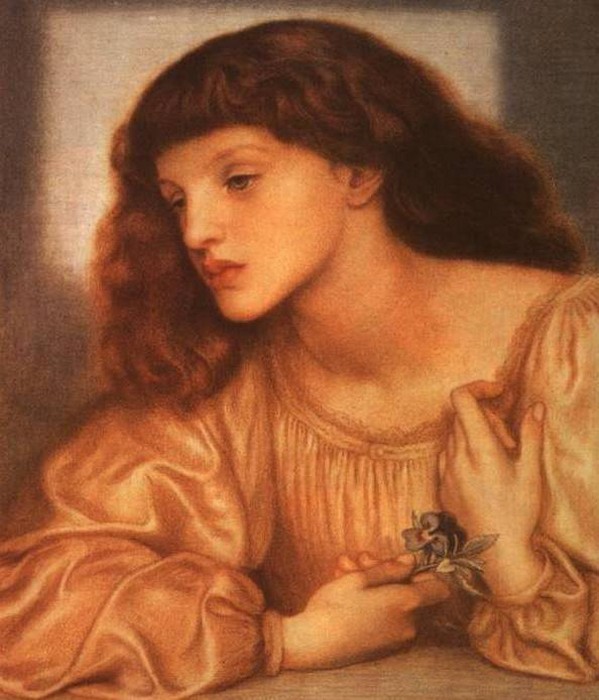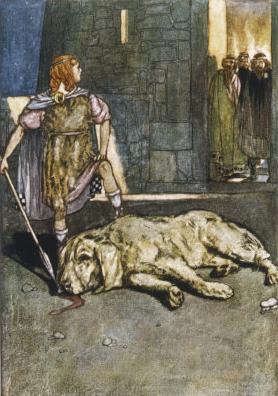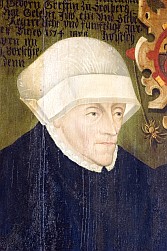|
Evelyn Gleeson
Evelyn Gleeson (15 May 1855 – 20 February 1944) was an English embroidery, carpet, and tapestry designer, who along with Elizabeth and Lily Yeats established the Dun Emer Press. Early life and education Evelyn Gleeson was born in Knutsford, Cheshire, on 15 May 1855. She was the daughter of an Irish doctor, Edward Moloney Gleeson. Her mother was Harriet (née Simpson), from Bolton, Lancashire. Edward had a practice in Knutsford, and whilst visiting Ireland he was struck by the unemployment and poverty, so much so he established the Athlone Woollen Mills in 1859 on the advice of his brother-in-law, a textile manufacturer in Lancashire. While the Gleeson family moved to Athlone in 1863, Evelyn attended school in England where she trained to be a teacher and then studied portraiture in London at the Atelier Ludovici from 1890 to 1892. From this, Gleeson went on to study design under Alexander Millar who was a member of the Arts and Crafts movement and a follower of William Morri ... [...More Info...] [...Related Items...] OR: [Wikipedia] [Google] [Baidu] |
Knutsford
Knutsford () is a market town in the borough of Cheshire East, in Cheshire, England. Knutsford is south-west of Manchester, north-west of Macclesfield and 12.5 miles (20 km) south-east of Warrington. The population at the 2011 Census was 13,191. Knutsford's main town centre streets, Princess Street (also known locally as Top Street) and King Street lower down (also known as Bottom Street), form the hub of the town. At one end of the narrow King Street is an entrance to Tatton Park. The Tatton estate was home to the Egerton family, and has given its name to Tatton parliamentary constituency, which includes the neighbouring communities of Alderley Edge and Wilmslow. Knutsford is near Cheshire's Golden Triangle, and on the Cheshire Plain between the Peak District to the east and the Welsh mountains to the west. Residents include ''Coronation Street'' actress Barbara Knox and footballers Peter Crouch, Sam Ricketts, Michael Jacobs and Phil Jagielka. History Knutsford, ... [...More Info...] [...Related Items...] OR: [Wikipedia] [Google] [Baidu] |
Women's Printing Society
The Women's Printing Society was a British publishing house founded in either 1874 or 1876 by Emma Paterson and Emily Faithfull with the company being officially incorporated as a cooperative in 1878. Involvement in the suffragist movement The company played an important role in British suffrage movement, both through its publication of feminist tracts and in providing employment opportunities for women in a field that had previously been restricted to men. The house was set up to allow women to learn the trade of printing, and provided an apprenticeship program. Women worked as compositors, and as of 1904, it was one of the few houses where they also did the imposing: ordering the galley proofs so that when folded, the front and back pages aligned properly. As of 1899, the company employed 22 women as compositors. The manager, proof-reader and bookkeeper were also women. Men held the tasks of "pressmen and feeders". The women apprentices earned a wage "considering the hours ... [...More Info...] [...Related Items...] OR: [Wikipedia] [Google] [Baidu] |
May Morris
Mary "May" Morris (25 March 1862 – 17 October 1938) was an English artisan, embroidery designer, jeweller, socialist, and editor. She was the younger daughter of the Pre-Raphaelite artist and designer William Morris and his wife and artists' model, Jane Morris (née Burden). Biography May Morris was born on 25 March 1862 at Red House, Bexleyheath, and named Mary, as she was born on the Feast of the Annunciation. May learned to embroider from her mother and her aunt Bessie Burden, who had been taught by William Morris. In 1878, she enrolled at the National Art Training School, precursor of the Royal College of Art. In 1885, aged 23, she became the Director of the Embroidery Department at her father's enterprise Morris & Co. During her time in the role she was responsible for producing a range of designs, which were frequently misattributed as her father's work. She ran this department until her father's death in 1896, where she moved into an advisory role. In 1886, May fel ... [...More Info...] [...Related Items...] OR: [Wikipedia] [Google] [Baidu] |
Emer
Emer (), in modern Irish Eimhear or Éimhear (with variations including Eimer, Eimear and Éimear) and in Scottish Gaelic Eimhir, is the name of the daughter of Forgall Monach and the wife of the hero Cú Chulainn in the Ulster Cycle of Irish mythology. Legend ''Tochmarc Emire'' "The Wooing of Emer" The Ulstermen searched all over Ireland for a suitable wife for Cú Chulainn, but he would have none but Emer. He visited her at Forgall's house at Lusk, County Dublin, and wooed her by trading cryptic riddles with her. Emer would accept Cú Chulainn as a husband, but only when his deeds justified it. However, Forgall was opposed to the match. He came to Ulster in disguise and suggested that Cú Chulainn should train in arms with the renowned warrior-woman Scáthach in Scotland, hoping the ordeal would be too much for him and he would be killed. Cú Chulainn took up the challenge. He learned all the arts of war from Scáthach, and while he was there slept with her rival A ... [...More Info...] [...Related Items...] OR: [Wikipedia] [Google] [Baidu] |
Cú Chulainn
Cú Chulainn ( ), called the Hound of Ulster (Irish: ''Cú Uladh''), is a warrior hero and demigod in the Ulster Cycle of Irish mythology, as well as in Scottish and Manx folklore. He is believed to be an incarnation of the Irish god Lugh, who is also his father. His mother is the mortal Deichtine, sister of king Conchobar mac Nessa. Born Sétanta, he gained his better-known name as a child, after killing Culann's fierce guard dog in self defence and offering to take its place until a replacement could be reared, hence he became the "Hound (''cú'') of Culann". He was trained in martial arts by Scáthach, who gave him the spear Gáe Bulg. It was prophesied that his great deeds would give him everlasting fame, but that his life would be short. At the age of seventeen he defends Ulster single-handedly against the armies of queen Medb of Connacht in the famous ''Táin Bó Cúailnge'' ("Cattle Raid of Cooley"). He is known for his terrifying battle frenzy (''ríastrad''), in ... [...More Info...] [...Related Items...] OR: [Wikipedia] [Google] [Baidu] |
Jack Butler Yeats
Jack Butler Yeats RHA (29 August 1871 – 28 March 1957) was an Irish art The history of Irish art starts around 3200 BC with Neolithic stone carvings at the Newgrange megalithic tomb, part of the Brú na Bóinne complex which still stands today, County Meath. In early-Bronze Age Ireland there is evidence of Beaker cult ...ist and Olympic medalist. W. B. Yeats was his brother. Butler's early style was that of an illustrator; he only began to work regularly in Oil paint, oils in 1906. His early pictures are simple lyrical depictions of Landscape painting, landscapes and figures, predominantly from the west of Ireland—especially of his boyhood home of County Sligo, Sligo. Yeats's work contains elements of Romanticism. He later would adopt the style of Expressionism. Biography Yeats was born in London, England. He was the youngest son of Irish portraitist John Butler Yeats and the brother of W. B. Yeats, who received the 1923 Nobel Prize in Literature. He grew up in Sligo w ... [...More Info...] [...Related Items...] OR: [Wikipedia] [Google] [Baidu] |
Augustine Henry
Augustine Henry (2 July 1857 – 23 March 1930) was a British-born Irish plantsman and sinologist. He is best known for sending over 15,000 dry specimens and seeds and 500 plant samples to Kew Gardens in the United Kingdom. By 1930, he was a recognised authority and was honoured with society membership in Belgium, Czechoslovakia, Finland, France, and Poland. In 1929 the Botanical Institute of Peking dedicated to him the second volume of ''Icones plantarum Sinicarum'', a collection of plant drawings. In 1935, ''John William Besant'' was to write: 'The wealth of beautiful trees and flowering shrubs which adorn gardens in all temperate parts of the world today is due in a great measure to the pioneer work of the late Professor Henry'.Besant, J. W. (1935) 'Plantae Henryanae', ''Gard. Chron.'' 98 (9 November 1935): 334–335. Early life and education Henry was born on 2 July 1857 in Dundee, Scotland to Bernard (a flax merchant) and Mary (née McManee) Henry; the family returned to ... [...More Info...] [...Related Items...] OR: [Wikipedia] [Google] [Baidu] |
Pioneer Club (women's Club)
The Pioneer Club was a self-consciously progressive women's club founded in Regent Street, London, in 1892 by the social worker and temperance activist Emily Massingberd.David Doughan Pioneer Club (act. 1892–1939) ''Oxford Dictionary of National Biography'', Oxford University Press. Accessed 30 May 2012. "It was strongly associated with the ' higher thought' and such associated issues of the 'New Morality' of the late nineteenth century as theosophy, anti-vivisection, anti-vaccination and above all feminism." The club was named after Walt Whitman's poem 'Pioneers! O Pioneers!', lines from which were inscribed on a glass screen in the building's hall: We the route for travel clearing Pioneers, O Pioneers! All the hands of comrades clasping Pioneers, O Pioneers! One of the most popular of the Women's Clubs established in London in the late 19th century by 1895 membership exceeded 300. It began in Regent Street but soon moved to 22 Cork Street. Its permanent site was at 22 Bruton ... [...More Info...] [...Related Items...] OR: [Wikipedia] [Google] [Baidu] |
Women's Suffrage
Women's suffrage is the right of women to vote in elections. Beginning in the start of the 18th century, some people sought to change voting laws to allow women to vote. Liberal political parties would go on to grant women the right to vote, increasing the number of those parties' potential constituencies. National and international organizations formed to coordinate efforts towards women voting, especially the International Woman Suffrage Alliance (founded in 1904 in Berlin, Germany). Many instances occurred in recent centuries where women were selectively given, then stripped of, the right to vote. The first place in the world to award and maintain women's suffrage was New Jersey in 1776 (though in 1807 this was reverted so that only white men could vote). The first province to ''continuously'' allow women to vote was Pitcairn Islands in 1838, and the first sovereign nation was Norway in 1913, as the Kingdom of Hawai'i, which originally had universal suffrage in 1840, r ... [...More Info...] [...Related Items...] OR: [Wikipedia] [Google] [Baidu] |
Gaelic Revival
The Gaelic revival ( ga, Athbheochan na Gaeilge) was the late-nineteenth-century Romantic nationalism, national revival of interest in the Irish language (also known as Gaelic) and Irish Gaelic culture (including Irish folklore, folklore, Irish mythology, mythology, Gaelic games, sports, Irish traditional music, music, arts, etc.). Irish had diminished as a spoken tongue, remaining the main daily language only in isolated rural areas, with English having become the dominant language in the majority of Ireland. Interest in Gaelic culture was evident early in the nineteenth century with the formation of the Belfast Harp Societies, Belfast Harp Society in 1808 and the Ulster Gaelic Society in 1830, and later in the scholarly works of Robert Shipboy MacAdam, John O'Donovan (scholar), John O'Donovan and Eugene O'Curry, and the foundation of the Ossianic Society. Concern for spoken Irish led to the formation of the Society for the Preservation of the Irish Language in 1876, and the ... [...More Info...] [...Related Items...] OR: [Wikipedia] [Google] [Baidu] |
Irish Literary Society
The Irish Literary Society was founded in London in 1892 by William Butler Yeats, T. W. Rolleston ,and Charles Gavan Duffy. Members of the Southwark Irish Literary Club met in Clapham Reform Club and changed the name early in the year. On 13 February they met again to form a committee. Evelyn Gleeson became secretary. Stopford Brooke gave the inaugural lecture to the society, on "The Need and Use of Getting Irish Literature into the English Tongue" (Bloomsbury House, 11 March 1893). The Society developed a proposal for a New Irish Library, a series of books to honor Irish culture, with Rolleston and Douglas Hyde as editors. Limerick man Michael MacDonagh, author and Parliamentary correspondent for the ''Times'', was an active member and editor of the Society's quarterly Gazette. ''A Book of Irish Verse'', designed to publicise the new societies, was published in 1895, edited by Yeats and dedicated "To the Members of the National Literary Society of Dublin and the Irish Literary ... [...More Info...] [...Related Items...] OR: [Wikipedia] [Google] [Baidu] |








